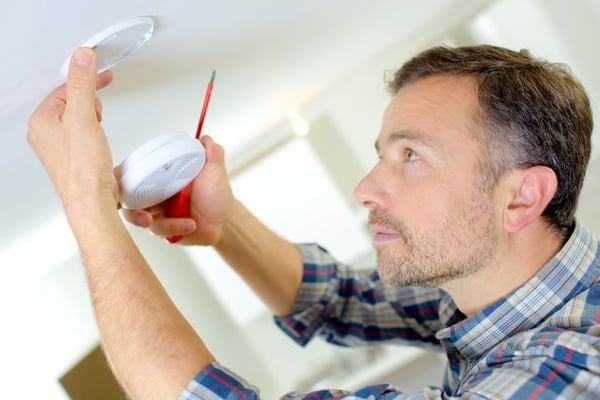
If you are like most homeowners, you want to do everything you can to protect your home and those you love who live there. Installing smoke alarms is one significant way you can do that.
However, while many homeowners have smoke alarms, they often neither understand the most effective locations and placement for their alarms, nor the proper testing and maintenance their alarms need to keep their home safe.
So, if you are planning to purchase and install smoke alarms in your home, or if your home already has them, but you aren’t sure they’re correctly installed or maintained, read on to learn all you need to know.
How Many Smoke Alarms Should You Install?
A home needs sufficient smoke alarm coverage to protect it and those inside from a fire. Unfortunately, many of our modern furnishings and styles are more susceptible to catching and spreading fire quickly than in times past, when furnishings were fewer and made of natural products. This means fires can get going more easily and spread more quickly.
Thus, smoke alarms need to be installed throughout the home. Having one or two will not be able to alert you in time to get out safely.
That said, the specific number that you need in your home depends on the number of levels, bedrooms, and additional spaces that you have. Thus, answering the following question will help you better determine the number that you need.
In Which Rooms Should You Install Smoke Alarms?
The NFPA calls for installing a smoke alarm:
- Inside each bedroom
- Outside of each sleeping area
- On every level of the home, including basements
- In a main living area, such as a living room, den, or family room
- At the base of the stairs leading to the upper level
For example, a single-story, 3-bedroom home with a split floor plan and no basement would likely need at least six smoke alarms (three for the bedrooms, two for outside the sleeping areas, and at least one more in the living space if the home is large enough to warrant it).
For larger homes, more may be required to adequately protect the living and activity spaces outside of the bedrooms and sleeping areas.
Properly Placing & Installing Smoke Alarms
In addition to knowing where in the house, smoke alarms should be, it is also important to understand where specifically within the space to place and install them.
- Proper location in a room/space: mount alarms either high on the wall or directly on the ceiling itself, as smoke rises. If you choose to mount it on the wall, the top of the alarm should be no more than 12 inches beneath the ceiling.
- Pitched ceilings: if you have a room with a pitched ceiling that will need an alarm, the placement will be slightly different. Install the alarm within three feet of the peak, but not within the peak’s apex, which is approximately four inches down from the peak on either side. So, essentially, place it anywhere between 4 inches to 36 inches down from the peak’s apex.
Where NOT to Place a Smoke Alarm
Importantly, there are a few places you should NOT place a smoke alarm because it may cause false positives or prevent the alarm from sounding at all. Never place a smoke alarm near:
- cooking appliances, furnaces, or fireplaces. Installing them too closely to these items will result in false positives. Alarms should be placed at least 10 ft from them.
- doors, windows, or ducts that would cause drafts, which may interfere with the alarm's ability to detect smoke and operate accurately.
When installing smoke alarms in your home, be sure to reference the above guidelines to help you determine the appropriate number and location of your alarms.
Testing & Caring for Your Smoke Alarms
Having or installing smoke alarms won’t mean anything, however, if you do not regularly test and maintain them to ensure they are in working order.
- How often should smoke alarms be tested? Test your alarms once a month to make sure they are working and do not need a new battery.
- How do you test smoke alarms? Simply press and hold the test button until the alarm sounds. It should be loud and strong. If the sound is weak or there is no sound, you need to replace the batteries.
- Other maintenance and care: During your monthly testing, take a moment to also dust and clean out your smoke alarm, as spider webs, debris, and dust can interfere with its ability to detect smoke effectively. Finally, change out the alarms’ batteries once a year, or if it has a non-accessible “long-life” battery, check the date to know when it’s time to replace the detector.
Make Sure Your Home is Protected
By following the above suggestions, as well as the manufacturer’s recommendations, as you install new, or check on your current smoke alarms, you should be able to ensure that your home is protected by the correct number of properly placed and installed smoke alarms. And by carrying out monthly testing and quick cleaning, you will make sure those alarms are ready to work should a fire occur.
If for any reason, you feel uncertain about your home’s fire protection or the best type and placement of smoke alarms for your home, the team at Koorsen Fire & Security would be happy to answer your questions and help direct you. Give Koorsen a call today to make sure your home is safe.


